 SCIA-value
SCIA-value
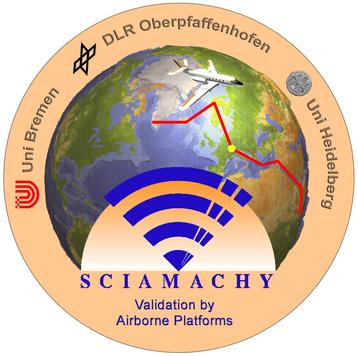
The SCIA-VALUE project aims to validate many of the data products from the SCIAMACHY instrument (Scanning Imaging Absorption spectroMeter for Atmospheric ChartographY) aboard ENVISAT. SCIA-VALUE is supported by DLR and will make a unique set of measurements from the pole to the equator using DLR's atmospheric research aircraft Falcon 20.
 Introduction
Introduction
 SCIAMACHY is the most comprehensive German
atmospheric observation experiment and has been developed in
collaboration with the Netherlands and Belgium as a national
contribution to the ESA ENVISAT. It is at 10.5 m in total length and a
weight of 8140 kg the largest environmental research satellite ever
developed. ENVISAT carries 10 experiments which probe different
aspects of the earth and its atmosphere.
SCIAMACHY is the most comprehensive German
atmospheric observation experiment and has been developed in
collaboration with the Netherlands and Belgium as a national
contribution to the ESA ENVISAT. It is at 10.5 m in total length and a
weight of 8140 kg the largest environmental research satellite ever
developed. ENVISAT carries 10 experiments which probe different
aspects of the earth and its atmosphere.
 ENVISAT with SCIAMACHY on
board was successfully launched by the ARIANE 5 rocket on the 28th of
February 2002 from the launch centre in Kourou, French Guyana. ENVISAT
and its payload is currently in a commissioning phase where its
instruments are tested. ENVISAT flies in an orbit over both poles in a
"sun synchronous" mode i.e. during each orbit it crosses the equator
at 10:00 am local time. Thus ENVISAT sees the entire surface of the
earth every three days.
ENVISAT with SCIAMACHY on
board was successfully launched by the ARIANE 5 rocket on the 28th of
February 2002 from the launch centre in Kourou, French Guyana. ENVISAT
and its payload is currently in a commissioning phase where its
instruments are tested. ENVISAT flies in an orbit over both poles in a
"sun synchronous" mode i.e. during each orbit it crosses the equator
at 10:00 am local time. Thus ENVISAT sees the entire surface of the
earth every three days.
SCIAMACHY is a novel experiment, which aims to study the global composition of the atmosphere from space. It is also a Greek word meaning hunting shadows and reflects the fact that the SCIAMACHY instrument measures solar radiation back scattered, from earth and its atmosphere. This is done in a variety of different viewing geometries.
A small scale version of SCIAMACHY, the GOME (Global Ozone Monitoring Experiment) instrument, which was originally called SCIA-mini, was launched as a proof of concept mission aboard the ESA ERS-2 and has now made seven years of successful measurements including the global distribution of stratospheric and tropospheric ozone, nitrogen dioxide, sulphur dioxide, formaldehyde, or bromine oxide. SCIAMACHY extends and enhances the scientific objectives of GOME by observing a much wider spectral range and therefore can detect more species, also it employs different viewing modes which allows to determine not only the total column amounts of trace gases but also their vertical distribution in the atmosphere.
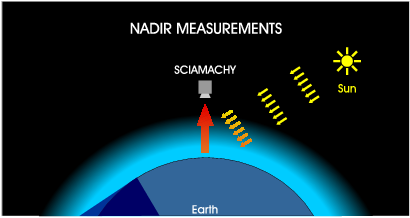
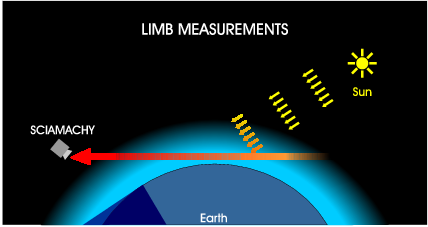
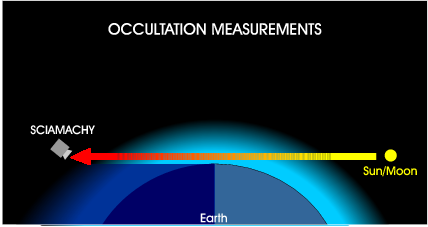
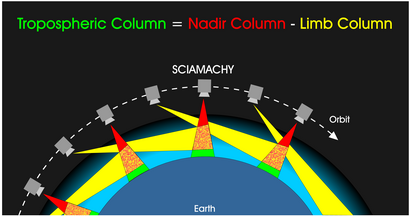
Light from the sun traverses the atmosphere and is absorbed and reflected both within the atmosphere and at the earth surface. SCIAMACHY measures the spectral distribution of the radiation from the earth's atmosphere at different viewing geometries. The finger print of the measured spectrum contains detailed information about the trace gas concentration of the atmosphere. For instance, about the amounts and distributions of stratospheric and tropospheric constituents. This retrieval exploits the technique developed in Germany and is known as Differential Optical Absorption Spectroscopy.

 Unique features of SCIAMACHY
Unique features of SCIAMACHYSCIAMACHY has many unique features:
 Application areas for SCIAMACHY
Application areas for SCIAMACHYThe main scientific objectives of SCIAMACHY are:
 The need for Validation of the SCIAMACHY Measurements and Data Products
The need for Validation of the SCIAMACHY Measurements and Data ProductsThe measurements and data products determined from scientific space-based instrumentation such as SCIAMACHY require validation. This means their comparison with measurements of the same quantity made using independent techniques and instrumentation. Validation determines the quality of the data products and is a pre-requisite for the meaningful application of the data from all sensors, particularly those used in the monitoring of atmospheric trends and climate change research.
Validation must take place throughout the lifetime of any instrument on a space platform but has an initial intensive phase in the beginning of the mission. An extensive validation of SCIAMACHY is being supported by DLR. One very important aspect of the SCIAMACHY Validation are the measurements to be made within the project SCIA VALUE (SCIAMACHY VALidation, and scientific Utilisation Experiment).
Validation also provides a unique opportunity for a first scientific exploitation of the measurements to be made by SCIAMACHY. The SCIA-VALUE is a good example of this concept because the simultaneous observations by SCIAMACHY, the instruments on board the Falcon aircraft, and the over-flights of the ground based stations around the world will provide data suitable for synergistic studies.
 The Falcon and SCIA-VALUE
The Falcon and SCIA-VALUEThe DLR Falcon has over the past 25 years demonstrated its capability as one of the leading research aircraft platforms in the world. Since it was brought into service it has established an enviable record of reliability and has participated in all the significant European and international atmospheric research expeditions in the last 15 years.
Many features were added to the Falcon in order to allow the deployment of various in situ and remote sensing experiments including three large optical windows (diameter 40 cm), two in the bottom and one in the roof, and a specially manufactured polyethylene window, transparent for microwaves. The Falcon has a maximum endurance of 5 h carrying a payload of 1,100 kg and a maximum operating altitude of 45,000 ft. Due to recent modifications with new engines and electric generators which yield an excellent range/height performance, the DLR Falcon is the only airborne European platform suitable for this project.
The SCIA VALUE project selected a novel combination of three different remote sensing experiments to fly on the DLR Falcon and a very challenging route to provide hemispheric validation of a variety of different data products from SCIAMACHY.
 The SCIA-VALUE payload
The SCIA-VALUE payload 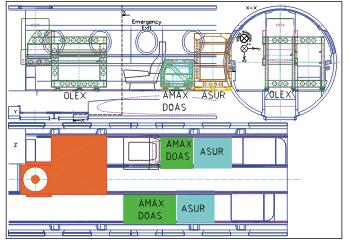
The SCIA-VALUE payload comprises three state of the art experiments for atmospheric remote sounding: AMAXDOAS: Airborne Multi-Axis Differential Optical Absorption Spectrometer developed and operated by both IUP Bremen and IUP Heidelberg. ASUR: Airborne SUbmillimeter wave Radiometer, developed and operated by IUP Bremen. OLEX: Ozone Lidar EXperiment developed and operated by DLR.
 AMAXDOAS
AMAXDOAS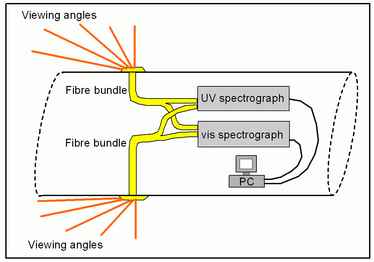 AMAXDOAS has similarities to SCIAMACHY
because it measures the radiance reaching the Falcon from a selected
set of viewing angles. It is an experiment developed jointly by the
University of Bremen and the University of Heidelberg. It retrieves
tropospheric and stratospheric columns of key gases (O3,
NO2, BrO, and OClO) inverted from SCIAMACHY measurements.
AMAXDOAS has similarities to SCIAMACHY
because it measures the radiance reaching the Falcon from a selected
set of viewing angles. It is an experiment developed jointly by the
University of Bremen and the University of Heidelberg. It retrieves
tropospheric and stratospheric columns of key gases (O3,
NO2, BrO, and OClO) inverted from SCIAMACHY measurements.
 ASUR
ASUR The Airborne SUbmillimeter wave Radiometer
(ASUR) is a passive microwave sensor operated on board an aircraft
flying near the tropopause. Using an up-looking geometry thermal
radiation originating from rotational emission lines of stratospheric
trace gases is measured in the frequency range from 604 to 662 GHz
(approx. 0.45 to 0.5 mm). Within this range key species of the
stratospheric ozone chemistry, like ClO, HCl, HNO3, the
dynamical tracers N2O and CH3Cl, as well as
water vapour and ozone can be detected. From the pressure broadening
of the spectral lines vertical profiles of volume mixing ratios are
retrieved over an altitude range from 15 to 65 km.
The Airborne SUbmillimeter wave Radiometer
(ASUR) is a passive microwave sensor operated on board an aircraft
flying near the tropopause. Using an up-looking geometry thermal
radiation originating from rotational emission lines of stratospheric
trace gases is measured in the frequency range from 604 to 662 GHz
(approx. 0.45 to 0.5 mm). Within this range key species of the
stratospheric ozone chemistry, like ClO, HCl, HNO3, the
dynamical tracers N2O and CH3Cl, as well as
water vapour and ozone can be detected. From the pressure broadening
of the spectral lines vertical profiles of volume mixing ratios are
retrieved over an altitude range from 15 to 65 km.
 OLEX
OLEX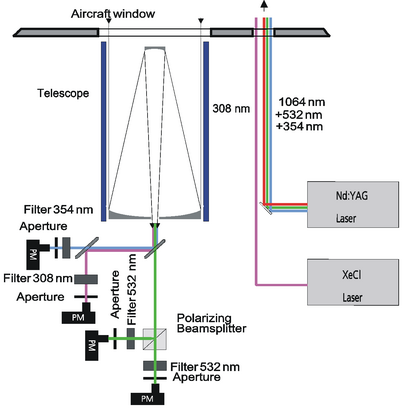 The Ozone Lidar EXperiment (OLEX)
measures the atmospheric backscatter at four wavelengths 308, 355,
532, and 1064 nm with the additional capability to measure the
cross-polarised return at 532 nm for particle phase discrimination. In
the zenith looking mode the system provides high resolution
two-dimensional cross sections of ozone number densities, aerosol
extinction, and cirrus cloud cover information from about 2 km above
aircraft flight level up to a height of 30 km.
The Ozone Lidar EXperiment (OLEX)
measures the atmospheric backscatter at four wavelengths 308, 355,
532, and 1064 nm with the additional capability to measure the
cross-polarised return at 532 nm for particle phase discrimination. In
the zenith looking mode the system provides high resolution
two-dimensional cross sections of ozone number densities, aerosol
extinction, and cirrus cloud cover information from about 2 km above
aircraft flight level up to a height of 30 km.
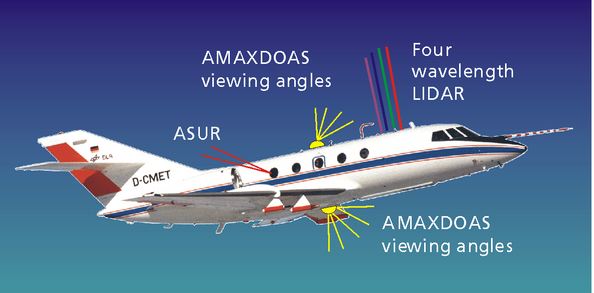 The SCIA-VALUE campaign is aimed at
validating selected stratospheric and tropospheric data products from
SCIAMACHY. It is planned to perform two main campaigns scheduled to
take place in September 2002 and February 2003, respectively. Both
campaigns will consist of large-scale latitudinal cross sections from
the polar regions to the tropics as well as longitudinal cross section
at polar latitudes at about 70°N. The two campaigns are performed
under different seasonal conditions. Each campaign consists of several
flight missions for dedicated case studies in the mid-latitude/arctic
as well as the mid-latitude/tropical region.
The SCIA-VALUE campaign is aimed at
validating selected stratospheric and tropospheric data products from
SCIAMACHY. It is planned to perform two main campaigns scheduled to
take place in September 2002 and February 2003, respectively. Both
campaigns will consist of large-scale latitudinal cross sections from
the polar regions to the tropics as well as longitudinal cross section
at polar latitudes at about 70°N. The two campaigns are performed
under different seasonal conditions. Each campaign consists of several
flight missions for dedicated case studies in the mid-latitude/arctic
as well as the mid-latitude/tropical region.
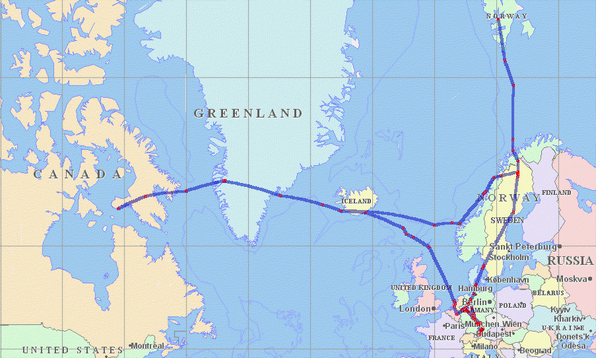 In the northern part at
high altitudes, additional case studies will be flown, e.g. in the
east west direction, where more than one adjacent orbit of SCIAMACHY
can be linked during a single flight. In particular, the northern
route extends from Munich via Kiruna in northern Sweden to Spitzbergen
and then across the Northern Atlantic to Iceland and Greenland. This
will enable both air pollution measurements over Europe and studies of
the composition of the stratosphere at the end of the summer prior to
the development of the polar vortex.
In the northern part at
high altitudes, additional case studies will be flown, e.g. in the
east west direction, where more than one adjacent orbit of SCIAMACHY
can be linked during a single flight. In particular, the northern
route extends from Munich via Kiruna in northern Sweden to Spitzbergen
and then across the Northern Atlantic to Iceland and Greenland. This
will enable both air pollution measurements over Europe and studies of
the composition of the stratosphere at the end of the summer prior to
the development of the polar vortex.
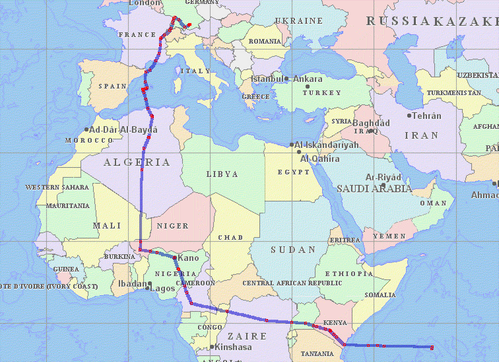 The southern route ranges
from Munich to Lagos on the west side of Africa and then across to
Kenya and to the Seychelles. This route has as its major objective the
validation of SCIAMACY data products of significance for air quality
and the study of biomass burning, thunderstorms, and convective
uplifting.
The southern route ranges
from Munich to Lagos on the west side of Africa and then across to
Kenya and to the Seychelles. This route has as its major objective the
validation of SCIAMACY data products of significance for air quality
and the study of biomass burning, thunderstorms, and convective
uplifting.
 Conclusions
ConclusionsValidation of the measurements from a space borne sensor such as SCIAMACHY is a pre-requisite for the assessment of their quality and their use in both scientific and operational applications. The SCIA-VALUE project is the cornerstone of the first phase of the SCIAMACHY Validation, taking place in the first year of the instrument's mission.
SCIA-VALUE has a complementary and novel set of experiments, which provide validation of the SCIAMACHY data products from the mesosphere to the ground. In addition the SCIA-VALUE is a self standing set of measurements, which will be exploited in combination with the simultaneous measurements by SCIAMACHY and at ground to gain further insight in the complicated processes governing physics and chemistry of the earth's atmosphere:
 Partners
Partners Klaus Bramstedt
/ Last Change.
Klaus Bramstedt
/ Last Change.